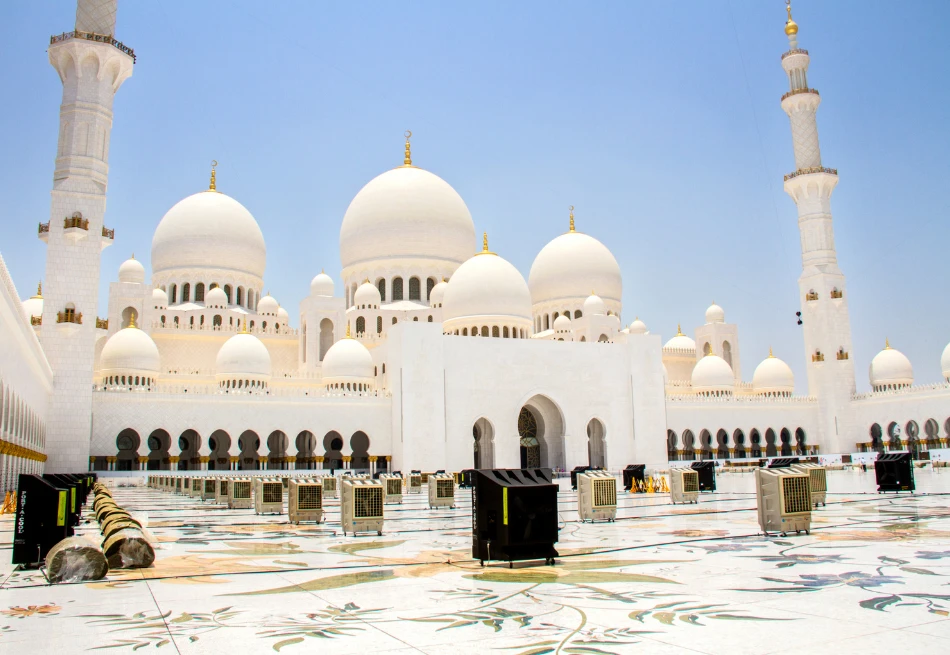
Though Sheikh Zayed Grand Mosque attracts millions of visitors worldwide, most visitors are unaware about its unique facts.
Do you know that Sheikh Zayed is one of the largest mosques in the world?
And that it holds the Guinness World Record for the world’s largest hand-knotted carpet by 1200 traditional craftsman?
Are you aware that it cost AED 2 billion ($545 million) to construct the Mosque? Also, do you know the mosque can hold 40,000 people at any given time?
The facts about its seven large chandeliers—weighing 12 tons and made of 24-carat gold, 82 domes, and 1192 columns, the rectangular-shaped floral courtyard, will definitely leave you awestruck.
Mentioned below are some really interesting facts about Sheikh Zayed Grand Mosque.
The Carpet has 2.5 billion knots
The Grand Mosque got itself into the Guinness World Record for having the largest hand-knotted carpet in the world in 2007.
More than 1200 craftsmen from Iran worked for two years to complete it.
This hand-knotting skill is passed on from generation to generation, and it has 2.5 billion knots and weighs 35 tons.
It covers an area of 5400 square meters (58,125 square feet), consisting of 70% wool and 30% cotton.
Insider Tip! For a more worthwhile experience, make sure you utilise the virtual tour of Abu Dhabi Sheikh Zayed Grand Mosque.
Seven chandeliers were imported from Germany

Among the seven chandeliers imported from Germany, the one that hangs in the main prayer hall is the largest.
These chandeliers contain around 40 million crystal balls in green, red, and yellow colors incorporated throughout the pattern.
Its style features an upturned palm tree, symbolizing the UAE’s prosperity.
The chandelier is made of Swarovski crystal, which is covered with 24-carat gold.
Italian Murano glass panels embellished with crystal, brass, and stainless steel were also used in its making.
Step inside the awe-inspiring Sheikh Zayed Grand Mosque to uncover this architectural masterpiece’s majestic beauty and serene secrets!
Domes imitate the moon’s phases and colors
The Grand Mosque’s domes are another architectural wonder. It has 82 domes in different sizes. The three integral domes are right above the main prayer halls.
You can see outstanding designs with gold-plated Quranic verses beneath each dome using the Glass-Reinforced Gypsum (GRG) technique.
Moreover, light effects from the 22 lighting towers provide unparalleled beauty to domes, from dim gray cloud light (when the moon is a crescent shape) to bright blue light (when it is a full moon).
Signature marbles were imported from many places
Sivec marble, sourced from Macedonia, is widely utilized in the Mosque because of its natural white hue, which amplifies the building’s luminosity.
Italy’s Lasa marble, which pairs well with the Sivec marble in some parts of the Mosque, is renowned for its extraordinary brilliance.
India’s Makrana Marble is well-known for being used in the Taj Mahal, but it was also picked for this Mosque for its premium quality and sturdiness.
Italian marble Aquabiana and Biano are used in certain decorative components of the Mosque, contributing to its elaborate patterns.
China’s East White and Ming Green Marble are used because of their distinct hues and textures, helping enhance the Mosque’s intricate interior design.
Greece’s Thassos Marble is a pure white marble. This has been utilized in spaces requiring a reflective, brilliant surface.
Planning to visit Sheikh Zayed Grand Mosque from Dubai? Follow the link for the best travel tips.
The construction took 11 years

The Abu Dhabi Sheikh Zayed Grand Mosque’s construction lasted for 11 years, starting from 1996 and ending in 2007.
It was influenced by Mughal, Ottoman, and Persian architecture, preserving the traditional style while incorporating modern art and architecture.
The external and internal columns are decorated like an upturned palm tree using semi-precious stones, including mother of pearl, red agate, lapis lazuli, and amethyst.
Mihrab (the place where the Imam stands for the prayer—it’s on the Qibla wall facing the holy place Mecca) showcases beehives as if they are rivers of honey. It is made of marble, gold, semi-precious stones, and ceramics.
Global resources were used to build the Mosque
The Sheikh Zayed Grand Mosque uses elements from all over the world, conveying a strong message of welcome and inclusiveness.
It serves as a reminder that, in spite of our differences, every member of the human race is important and interconnected.
Let us see some of the global resources used in this Grand Mosque:
- India: Makrana marbles excavated from Rajasthan were used for the annexes and offices at the Mosque
- Italy: Lasa from Laas (South Tyrol) was used in the internal elevations and Acquabianca and Bianco P
- China: East White and Ming Green marble
- Germany: Seven chandeliers
- Morocco: Traditional Moroccan artistry
- United Kingdom: The Mosque’s distinctive lighting system features effects that gently change from white to blue to reflect the moon’s phases
- Turkey: Iznik tiles that trace back to the Ottoman Empire
- Newzeland: The wool
- Iran: 1200 Persian artisans hand-knotted the carpet with 2.5 billion knots
- Greece: Pentelic marble, known for its pure white appearance and fine grain, used in selected areas for contrast with other materials
- United Arab Emirates: Local stones and pearls
Did you know that you will be sent away from the mosque’s entrance if you aren’t dressed appropriately? Find out the Grand Mosque’s dress code.
Strategic elevation of the Mosque
Built on an elevated area, the mosque is prominently visible from various approaches, creating a striking visual landmark.
This also helps it become the focal point in Abu Dhabi’s skyline.
The bridges close to the Mosque connect most of the UAE’s major places, allowing visitors to access the place easily.
Sheikh Zayed’s main intention in building the Mosque was to unite the Islamic world with cultural diversity and promote interfaith dialogues and discourse. It is for this reason that the Mosque is built on the foundation of peace.
